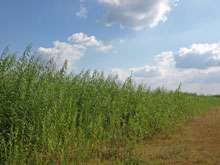New crops show potential for sustainable biomass

A new source of biomass grown on unused land could help the UK meet renewable energy targets without affecting food production or the environment, according to the results of a new study.
Researchers at Southampton University looked at the potential of short-rotation coppice (SRC) poplar and willow – so-called 'second generation' energy crops which are grown purely for biomass and don't come from food products like wheat.
Their results show that SRC could contribute 4 per cent of the UK's current target to produce 30 per cent of its electricity from renewable sources, and doesn't compete with food production or conservation.
But currently, energy crop yields are achieving less than 50 per cent of their potential.
By law, 15 per cent of all the UK's energy must come from renewable sources by 2020. It will take around 7.5 million tonnes of biomass for energy crops to meet their 1 per cent share of this target, and many people are worried about the effect this could have on other land uses and the environment.
Unlike traditional biomass, SRC can be grown on marginal land – land that isn't good enough arable farming or is simply disused – so it doesn't take land away from food crops or push prices up by doing so.
Nevertheless, SRC hasn't been adopted widely yet. 'This is partly down to financial barriers,' explains Professor Gail Taylor from Southampton's school of biological sciences, lead author of the research which is published in the journal Biofuels.
'But landowners can also be reluctant to take on new crops and technologies, and worry that these perennial crops will restrict their long-term use of the land. A cultural change is needed as well as a technological one for these crops to be accepted,' she continues.
In a project funded by the UK Energy Research Centre (UKERC), the researchers used models to predict whether SRC grown just on marginal land across England could produce the biomass needed.
They also looked at a range of social, economic and environmental factors, to see whether the crops would be profitable and what effect they would have on things like biodiversity and conservation areas.
The results showed that England's marginal land could produce 4 per cent of our target to get 30 per cent of our electricity from renewable sources, and that this wouldn't have the large detrimental effects on food production or the environment that some people fear.
'Overall, the effects on biodiversity were positive,' says Taylor. 'Different groups of plants and animals come to the fore in SRC compared with arable land, but the diversity of both increases.'
Because of their large areas of marginal land, the southwest and northwest of England have the potential to produce more than a third of the total biomass needed.
This regionalisation is important, say the researchers: it means that in the future different areas could take a more local approach to the balance of biomass versus other fuel sources.
If bioenergy is going to be viable and sustainable, the researchers write, careful consideration must be given to making sure energy crops are both economically competitive and complementary to other types of land use.
This story is republished courtesy of Planet Earth online, a free, companion website to the award-winning magazine Planet Earth published and funded by the Natural Environment Research Council (NERC).
More information: Matthew J Aylott, Eric Casella, Kate Farrall, Gail Taylor, 2010, Estimating the supply of biomass from short-rotation coppice in England, given social, economic and environmental constraints to land availability. Biofuels, 1(5), 719-717
Provided by PlanetEarth Online

















